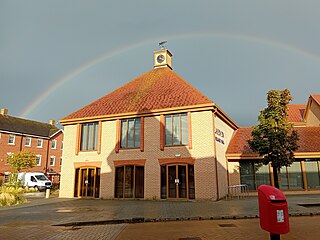
John Bunyan was an English writer and Puritan preacher. He was baptised 30th November 1628 and lived until 31st August 1688. He is best remembered as the author of the Christian allegory The Pilgrim's Progress, which also became an influential literary model. In addition to The Pilgrim's Progress, Bunyan wrote nearly sixty titles, many of them expanded sermons.

Bedfordshire is a ceremonial and historic county in the East of England. It is bordered by Northamptonshire to the north, Cambridgeshire to the north-east, Hertfordshire to the south-east, and Buckinghamshire to the west. The largest settlement is Luton.

Bedford is a market town in Bedfordshire, England. At the 2011 Census, the population of the Bedford built-up area was 106,940, making it the second-largest settlement in Bedfordshire, behind Luton. Bedford is also the historic county town of Bedfordshire and is now the seat of the Borough of Bedford, a unitary authority that includes other settlements and a significant rural area.

Kempston is a town and civil parish in the Borough of Bedford, Bedfordshire, England, situated around 2 miles (3.2 km) south-west of Bedford town centre. It had a population of 19,330 in the 2011 census, and forms part of the wider Bedford built-up area. The River Great Ouse separates it from the Queen's Park area of Bedford.

Houghton House is a ruined mansion house in the parish of Houghton Conquest, Bedfordshire. It is a Grade I listed building, positioned above the surrounding countryside, and commands excellent views. Built from 1615 to 1621, it is said that the house was the model for House Beautiful in John Bunyan's The Pilgrim's Progress (1678). It was abandoned in 1794 and stripped of its interiors and roof for sale as building supplies. Today the property is owned by English Heritage, and is open to free public access during daylight hours.

Bedfordshire County Council was the county council of the non-metropolitan county of Bedfordshire in England. It was established on 24 January 1889 and was abolished on 31 March 2009. The county council was based in Bedford.

Elstow is a village and civil parish in the Borough of Bedford, Bedfordshire, England, about 2 miles (3.2 km) south of Bedford town centre.

Elstow Abbey was a monastery for Benedictine nuns in Elstow, Bedfordshire, England. It was founded c.1075 by Judith, Countess of Huntingdon, a niece of William the Conqueror, and therefore is classed as a royal foundation.

Wixams is a new town and civil parish located in Bedfordshire, England, which has been under construction since early 2007. It is expected to become the third largest settlement in the Borough of Bedford after Bedford itself and Kempston, and one of the largest new settlements founded in England since the British new towns movement of the first twenty five years after World War II.

Cauldwell is an electoral ward and area within the town of Bedford, England.
Bedford Academy is a mixed secondary school and sixth form located in the Kingsbrook area of Bedford, Bedfordshire, England.

John Bunyan Museum is a museum primarily dedicated to the life, times and works of John Bunyan. The museum is located in Bedford, Bedfordshire, England.

A bronze statue of John Bunyan stands on St Peter's Green, Bedford, England. The statue was sculpted by Sir Joseph Edgar Boehm, it was erected in 1874, and unveiled on 10 June of that year. The statue was commissioned by the Ninth Duke of Bedford and presented by him to Bedford town.

The Shire Hall is a municipal building in St Paul's Square, Bedford, Bedfordshire. The shire hall, which was the headquarters of Bedfordshire County Council from 1888 to 1969, is a Grade II listed building.

The Old Town Hall is a municipal building in St Paul's Square in Bedford, Bedfordshire, England. The building, which was the headquarters of Bedford Borough Council from 1892 to 2009, is a Grade II listed building.
Elstow is a civil parish in Bedford, Bedfordshire, England. It contains 31 listed buildings that are recorded in the National Heritage List for England. Of these, three are listed at Grade I, two are listed at Grade II*, the middle of the three grades, and the others are at Grade II, the lowest grade. The parish adjoins the large town of Bedford. Almost all the listed buildings are houses. Also listed are a church, a moot hall, two public houses and the ruined Hillersdon mansion.

The Moot Hall is a municipal building in Market Cross Place in Aldeburgh, Suffolk, England. The building, which is the meeting place of Aldeburgh Town Council, is a Grade I listed building.

Humphrey Radcliffe was an English landowner and Member of Parliament.

The Moot Hall is a former municipal building in the Market Place in St Albans, Hertfordshire, England. The building, which now operates as two shops with office space above, is a Grade II listed building.

The Moot Hall is a civic building in Market Rasen Road, Holton le Moor, Lincolnshire, England. The building, which continues to be used for civic meetings, was built in 1910.



















